Putting dots on Li: Do I need to train lithium batteries?
Enough time has passed since the time when Ni-Cd and Ni-Mh batteries reigned supreme in mobile devices, but right from the beginning of the era of Li-ion and Li-pol, the debate over whether these batteries should be “tamed” does not abate. immediately after purchase.
It comes to the ridiculous, in the discussion thread of the ZP100 on the china-iphone all newcomers were recommended to go through 10 charge-discharge cycles in an authoritative tone, and only then come up with questions about batteries.

Let's try to figure out whether such a recommendation has the right to life, or it is the reflexes of the spinal cord (in the absence of the brain, probably) of some individuals who have remained with them since the days of nickel batteries.
The text can and certainly contains spelling, punctuation, grammar and other types of errors, including semantic ones. The author will be grateful for information about them (of course, in private, and even better with the help of this wonderful extension ), but does not guarantee their elimination.
')
In Google, a datasheet for a battery consisting of one page was found:
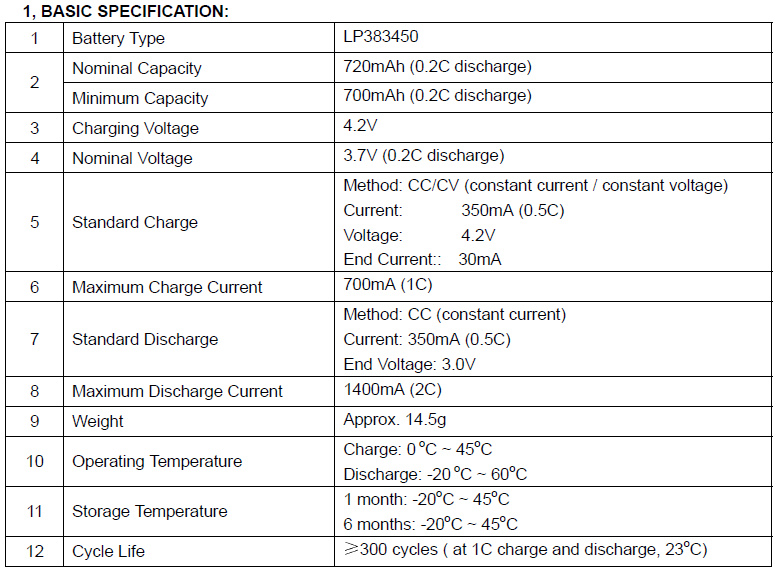
Decipher what is written there.
I think that such a Nominal capacity and Minimum capacity is clear to everyone - the usual capacity, and the minimum capacity. The designation of 0.2 C means that it reaches such capacity only if it is discharged with a current of 0.2 of its capacity - 720 * 0.2 = 144 mA.
Charding voltage and Nominal Voltage - Charging voltage and operating voltage is also simple and straightforward.
But the next item is already more difficult - Charging.
Method: CC / CV - It means that the first half of the charging process is necessary to maintain a constant current (it is listed below, 0.5C is standard - that is, 350mA, and 1C is maximum - 700mA). And after reaching the voltage on the battery 4.2v, it is necessary to establish a constant voltage, the same 4.2v.
Item below - Standart Discharge , Discharge. They offer to discharge current from 0.5 - 350mA and up to 2 - 1400mA to a voltage of 3V. Manufacturers are cunning - at such currents the capacity will be lower than stated.
The maximum discharge current is determined by the internal resistance. But it is necessary to distinguish between the maximum discharge current and the maximum allowable. If the first can be 5A, and even more, then the second is strictly stipulated - no more than 1.4A. This is due to the fact that at such high discharge currents the battery begins to irreversibly collapse.
Next comes information on weight and temperature: charging from 0 to 45 degrees, discharge from -20 to 60. Storage temperature: from -20 to 45 degrees, usually with a charge of 40% -50%.
The life time is promised at least 300 cycles (full discharge-charge current 1C) at a temperature of 23 degrees. This does not mean that after a 300 cycle the battery will turn off and no longer turn on, no. Simply, the manufacturer guarantees that 300 cycles of battery capacity will not fall. And then - as lucky, it depends on currents, temperature, working conditions, the party, the position of the moon, and so on.
The standard method by which all lithium batteries are charged (li-pol, li-ion, lifepo, only currents and voltages are different) is the CC-CV mentioned above.
At the very beginning of the charge we maintain a constant current. Usually this is done with a feedback circuit in the charger — the voltage is automatically selected so that the current passing through the battery is equal to the required one.
As soon as this voltage becomes 4.2 volts (for the described battery), such a current cannot be maintained any more - the voltage on the battery will increase too much (we remember that the operating voltage of lithium batteries cannot be exceeded), and it can heat up and even explode.
But now the battery is not fully charged - usually by 60% -80%, and to charge the remaining 40% -20% without explosions, the current must be reduced.
The easiest way to do this, maintaining a constant voltage on the battery, and he will take the kind of current that he needs. By reducing this current to 30-10mA, the battery is charged.
To illustrate all of the above, Ipainted in Photoshop I prepared a charge chart, taken from an experimental battery:

On the left side of the graph, highlighted in blue, we see a direct current of 0.7A, while the voltage gradually rises from 3.8V to 4.2V. You can also see that for the first half of the charge the battery reaches 70% of its capacity, while for the remaining time - only 30%
The following battery was chosen as the test subject:

Imax B6 was connected to it (I wrote about it here ):
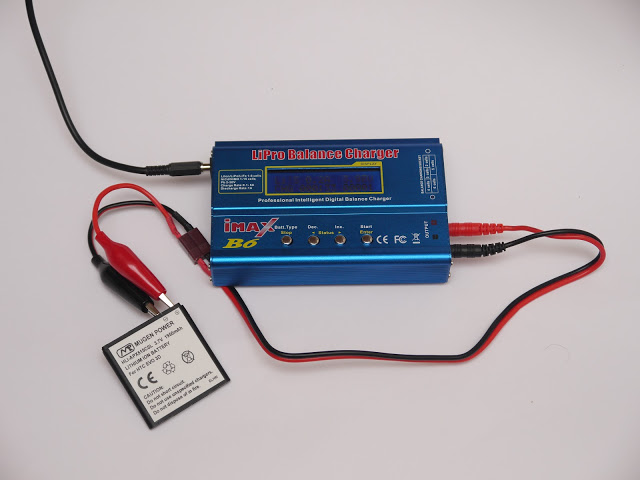
Which poured information about the charge-discharge to the computer. Charts were built in LogView.
Then I just came up every few hours and alternately turned on the charge-discharge.
As a result of painstaking work (and you yourself try to poke the exercises for 2 weeks) two schedules were obtained:
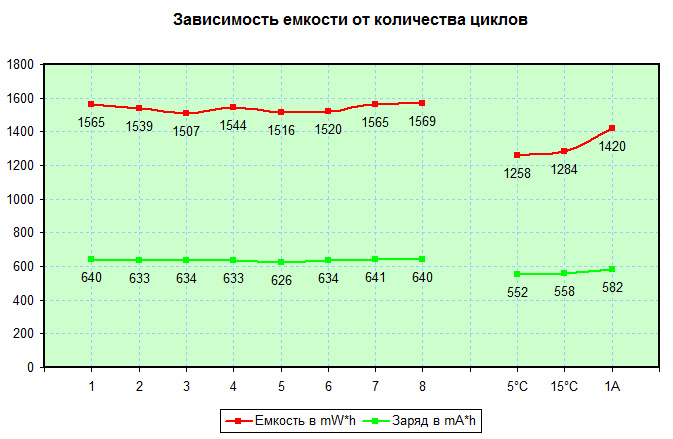
As its name implies, it shows the change in battery capacity over the first 10 cycles. It floats a little, but the fluctuations are about 5% and have no tendency. In general, the battery capacity does not change. All points are removed when discharging current 1C (0.7A), which corresponds to the active work of the smartphone.
Two of the three points at the end of the graph show how the capacity changes at low battery temperature. The latter is how the capacity changes when discharging with a large current. This is the following chart:

Indicates that the greater the discharge current - the less energy can be obtained from the battery. Although, Hochma, even on the smallest current of 100 mA, the battery in terms of capacity does not correspond to the data sheet. Everyone lies.
Although no, the Mugen Power battery test for 1900mAh for the Zopo ZP100 showed quite honest almost two amps:

But the Chinese 5000mAh battery scored a total of 3000:
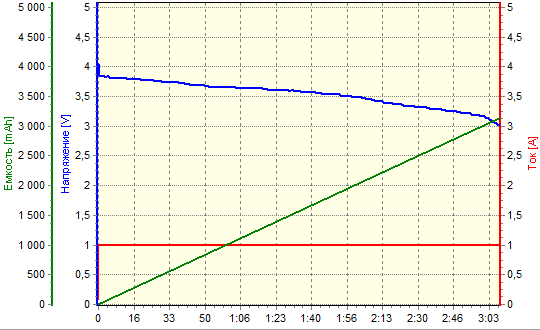
It comes to the ridiculous, in the discussion thread of the ZP100 on the china-iphone all newcomers were recommended to go through 10 charge-discharge cycles in an authoritative tone, and only then come up with questions about batteries.

Let's try to figure out whether such a recommendation has the right to life, or it is the reflexes of the spinal cord (in the absence of the brain, probably) of some individuals who have remained with them since the days of nickel batteries.
The text can and certainly contains spelling, punctuation, grammar and other types of errors, including semantic ones. The author will be grateful for information about them (of course, in private, and even better with the help of this wonderful extension ), but does not guarantee their elimination.
')
About terminology
- A (Ampere (A), or milliamperes - mA , microampere - µA ) is the value of the current strength in the conductor. It can be both big and small. The current in 100A can weld sheets of iron, but if you take the wires from BP 5V 100A in your hands, you will not feel anything, because no 100A will pass through your skin - the body’s resistance is too large for current to flow.
- B (Volt (V), or millivolt - mV , microvolt - µV ) is the voltage value. A large voltage will create a long spark, but with a small current source you will only crack, but will not turn into a handful of ashes. An example is static electricity, the voltage is up to 10kV, and the currents are meager.
- Ohm (Ohm (Ohm), or kilo - kOhm , mega - MOhm ) - the value of resistance. It is the high resistance of your body (approximately 15 kΩ) that allows you to hold the wires from the first point. Passing through a wire that has resistance (and all wires have resistance, and the thinner the wire is
from the province of China, the higher it is), the voltage drops by a certain amount, which depends on the strength of the current. Therefore, a thick wire is needed for the heater, and a thin one for the bulb, even though the voltage in both cases is 220V. With regard to batteries and batteries (and indeed to all current sources), we can talk about internal resistance. This resistance will not allow you to get a high current in a short time, although the battery during a short circuit tends to do this very much - the spark that occurs when the terminals are closed is just a few amperes of current at a voltage less than a volt. This is due to the fact that the rate of ions inside the battery is not very high.Get stuck, poor things, knee-deep in polymer - Watt (Watt (W), or milliwatts - mW , then you understand, yes?) - in the simplest representation, this is the DC power calculated by multiplying volts by amps. For example, a laptop's PSU, which outputs 3A at a voltage of 20V, and a laboratory power supply unit that delivers 3V, at a current of 20A, will give to the load the same power of 60W. They will consume more from the network, due to the fact that their efficiency is not 100% - some of the energy will be transferred to heat.
- W · h (Watt-hour) - a measure of energy. From the name it should be clear that 1 W · h is the energy that someone will receive (or give), receiving (or giving) a power of 1W for an hour. Or 60W in a minute. Here is the BP above, it just gives every hour 60W · h. This is the “right” capacity, which does not give information about the battery itself, but gives a complete picture of its capacity.
There are kilowatt-hours, kWh - they are written in the receipts. If you leave the power supply turned on, it will consume energy for a month at 60W · h * 24 * 30, i.e. approximately 43kWh, or 73 rubles. Of course, that which gives the power supply at the output (those 20B and 3A) should be consumed by someone, well, we don’t forget about efficiency, I simplified it. - A · h (ampere-hours) - Charge. It is generally accepted, albeit erroneously called capacity. Why wrong? Because without voltage, according to one 5A · h number, nothing can be understood - it only says that, for example, a battery can deliver a current of 5 amperes per hour. Or one amp for 5 hours. But how much energy will be released during this hour depends on the supply voltage and the voracity of the consumer. Simply put, A · h is W · h, from which volts have been torn out (W - B * A, if B is removed, A will remain). It would seem that it could be simpler - 2A · h, 3.7V is written on the battery, multiply 2 by 3.7, get 7.4W · h and rejoice. But there is a nuance (s). Here he is:
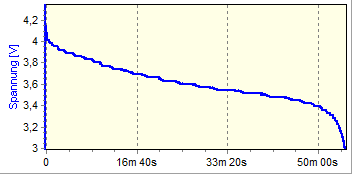
This is a graph of the discharge of a lithium battery, which shows that the voltage decreases by the end of the discharge. This means that a simple multiplication of · h by B (which would work in the case of a power supply that yields a stable voltage) gives an energy value with a very large error. In order to find out how many watt-hours a battery has, for example, you can build a graph of power (which can be obtained by multiplying the instantaneous values of current and voltage) and then find the area under the curve of this graph:
This is more complicated, but as a result we get watt-hours. - xC - just convenient designation of the charge or discharge current of the battery When they talk about charging with 2C or 0.1C, they usually mean that the current should be (2 * battery capacity) / h or (0.1 * battery capacity) / h.
For example, a battery with a capacity of 720mAh, for which the charge current is 0.5C, must be charged with a current of 0.5 * 720mAh / h = 360mA
Reading datasheets
In Google, a datasheet for a battery consisting of one page was found:

Decipher what is written there.
I think that such a Nominal capacity and Minimum capacity is clear to everyone - the usual capacity, and the minimum capacity. The designation of 0.2 C means that it reaches such capacity only if it is discharged with a current of 0.2 of its capacity - 720 * 0.2 = 144 mA.
Charding voltage and Nominal Voltage - Charging voltage and operating voltage is also simple and straightforward.
But the next item is already more difficult - Charging.
Method: CC / CV - It means that the first half of the charging process is necessary to maintain a constant current (it is listed below, 0.5C is standard - that is, 350mA, and 1C is maximum - 700mA). And after reaching the voltage on the battery 4.2v, it is necessary to establish a constant voltage, the same 4.2v.
Item below - Standart Discharge , Discharge. They offer to discharge current from 0.5 - 350mA and up to 2 - 1400mA to a voltage of 3V. Manufacturers are cunning - at such currents the capacity will be lower than stated.
The maximum discharge current is determined by the internal resistance. But it is necessary to distinguish between the maximum discharge current and the maximum allowable. If the first can be 5A, and even more, then the second is strictly stipulated - no more than 1.4A. This is due to the fact that at such high discharge currents the battery begins to irreversibly collapse.
Next comes information on weight and temperature: charging from 0 to 45 degrees, discharge from -20 to 60. Storage temperature: from -20 to 45 degrees, usually with a charge of 40% -50%.
The life time is promised at least 300 cycles (full discharge-charge current 1C) at a temperature of 23 degrees. This does not mean that after a 300 cycle the battery will turn off and no longer turn on, no. Simply, the manufacturer guarantees that 300 cycles of battery capacity will not fall. And then - as lucky, it depends on currents, temperature, working conditions, the party, the position of the moon, and so on.
About charging
The standard method by which all lithium batteries are charged (li-pol, li-ion, lifepo, only currents and voltages are different) is the CC-CV mentioned above.
At the very beginning of the charge we maintain a constant current. Usually this is done with a feedback circuit in the charger — the voltage is automatically selected so that the current passing through the battery is equal to the required one.
As soon as this voltage becomes 4.2 volts (for the described battery), such a current cannot be maintained any more - the voltage on the battery will increase too much (we remember that the operating voltage of lithium batteries cannot be exceeded), and it can heat up and even explode.
But now the battery is not fully charged - usually by 60% -80%, and to charge the remaining 40% -20% without explosions, the current must be reduced.
The easiest way to do this, maintaining a constant voltage on the battery, and he will take the kind of current that he needs. By reducing this current to 30-10mA, the battery is charged.
To illustrate all of the above, I

On the left side of the graph, highlighted in blue, we see a direct current of 0.7A, while the voltage gradually rises from 3.8V to 4.2V. You can also see that for the first half of the charge the battery reaches 70% of its capacity, while for the remaining time - only 30%
About testing technology
The following battery was chosen as the test subject:

Imax B6 was connected to it (I wrote about it here ):

Which poured information about the charge-discharge to the computer. Charts were built in LogView.
Then I just came up every few hours and alternately turned on the charge-discharge.
About the results
As a result of painstaking work (and you yourself try to poke the exercises for 2 weeks) two schedules were obtained:

As its name implies, it shows the change in battery capacity over the first 10 cycles. It floats a little, but the fluctuations are about 5% and have no tendency. In general, the battery capacity does not change. All points are removed when discharging current 1C (0.7A), which corresponds to the active work of the smartphone.
Two of the three points at the end of the graph show how the capacity changes at low battery temperature. The latter is how the capacity changes when discharging with a large current. This is the following chart:

Indicates that the greater the discharge current - the less energy can be obtained from the battery. Although, Hochma, even on the smallest current of 100 mA, the battery in terms of capacity does not correspond to the data sheet. Everyone lies.
Although no, the Mugen Power battery test for 1900mAh for the Zopo ZP100 showed quite honest almost two amps:

But the Chinese 5000mAh battery scored a total of 3000:

About conclusions
- Training lithium batteries, consisting of one can, is meaningless. Not harmful, but spends battery life cycles. In mobile devices, training cannot even be justified by the operation of the controller - the battery parameters are the same, they do not change depending on the model and time. The only thing that an insufficient discharge can affect is the accuracy of the charge indicator readings (but not the running time), but for this, one complete discharge every six months is enough.
Again. If you have a player, phone, radio, PDA, tablet, dosimeter, multimeter, clock, or any other mobile device that uses a Li-Ion or Li-Pol battery (if it is removable, it will be written on it, if it is not removable, then 99 % is lithium) - “training” longer than one cycle is useless. One cycle is probably useless too.
If you have a battery for controlled models, then the first few cycles should be discharged by small currents (small, hehe. For them, small ones are 3-5C. This is actually one and a half amperes at 11 volts. And working currents are up to 20C there). Well, who uses these batteries, he knows . And all the rest is not useful, except for common development. - In some cases, when using batteries with several banks, the full charge-discharge may increase capacity. In laptop batteries, if the manufacturer stints on a smart battery controller that does not balance banks in series with each charge, a full cycle can increase the capacity for the next couple of cycles. This happens by equalizing the voltage on all banks, which leads to their full charge. A few years ago I came across laptops with such controllers. Now I do not know.
- Do not believe the labels on the labels. Especially Chinese. In the past topic, I gave a link in which a huge test of Chinese batteries did not reveal any one whose capacity corresponded to the inscription. NONE! Always overstate. And if they do not overstate, they guarantee capacity only in greenhouse conditions and when discharged with a small current.
- Keep the battery warm. Smart jeans in your pocket will work a little longer than in the outer pocket of your jacket. The difference may be 30%, and in winter, and even more.
- Follow me. You can do this in my profile (button "subscribe").
Source: https://habr.com/ru/post/150661/
All Articles